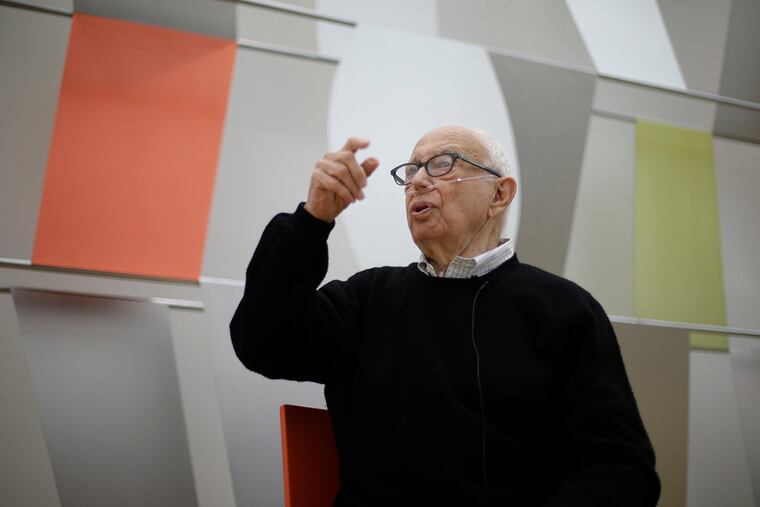Artist Ellsworth Kelly's Philadelphia legacy
The city's first piece of abstract public art - an iconic 1957 wall-mounted sculpture that once adorned Penn Center's Philadelphia Transportation Building at 17th and Market Streets - now nests in storage at New York's Museum of Modern Art. After several years of neglect, it was retrieved from Philadelphia in 1996 by the artist and his agent.

The city's first piece of abstract public art - an iconic 1957 wall-mounted sculpture that once adorned Penn Center's Philadelphia Transportation Building at 17th and Market Streets - now nests in storage at New York's Museum of Modern Art. After several years of neglect, it was retrieved from Philadelphia in 1996 by the artist and his agent.
But that is not Ellsworth Kelly's legacy in Philadelphia, where more than a dozen of his works are on prominent, permanent display, and one of his sculptures gleams on the Benjamin Franklin Parkway. Kelly, 92, died Sunday at his home in Spencertown, N.Y.
His landmark Sculpture for a Large Wall was surreptitiously relocated four decades after the then-34-year-old Kelly completed it, in the early days of what would become an illustrious career as one of America's most influential 20th-century abstract artists.
"Philadelphia, early on, recognized Kelly for the artist he was and would become," Timothy Rub, director of the Philadelphia Museum of Art, said Monday. "We gave him the opportunity to do something great."
That opportunity, offered in a commission from the storied Philadelphia architect Vincent Kling, produced a gigantic multicolored sculpture made of 104 anodized aluminum panels. Ever succinct, Kelly's title for the piece was Transportation Building Lobby Sculpture. The aluminum rectangles and trapezoid panels - some tilt forward, some backward - were spread across more than 65 feet.
"It's an absolute icon of modernism," said Judith F. Dolkart, chief curator at the Barnes Foundation from 2010 to 2014.
Dolkart helped bring it back to Philadelphia, albeit for just four months, in 2013 as part of a new series of temporary exhibitions at the Barnes' new building on the Parkway. She remembered Monday how Kelly reconnected in a new setting with the piece, now retiled Sculpture for a Large Wall, which consumed an entire wall of the exhibition gallery.
"You're really lost in it," said Dolkart, now the director of the Addison Gallery of American Art in Andover, Mass. "You're absolutely surrounded by it. It does give you a sense of what it is to conceive a work that is so monumental."
How it was lost still stings the city's cultural community. The Greyhound bus terminal moved from the Transportation Building to Chinatown in 1987. In 1993, Conrail left the building, and the whole structure was fenced off and shuttered - with Kelly's privately owned mural inside.
Matthew Marks, the New York art dealer who represented Kelly, came to Philadelphia in 1995 to see an exhibition and, at Kelly's urging, checked on his work. He found the building abandoned, the sculpture mothballed.
When its owners, the Rubin Organization, found a new tenant - the law firm Morgan, Lewis & Bockius - remodeling plans did not call for inclusion of Kelly's piece, and the artist was alarmed. Marks offered $100,000 for it, Kelly oversaw its dismantling, and it went on the market in New York unbeknownst to the Philadelphia cultural community. It was sold in 1998 for a reported $1 million to cosmetics scion Ronald S. Lauder, who gave it to the Museum of Modern Art.
"I have to say that it never even occurred to me that it could be removed or moved," said Anne d'Harnoncourt, at the time director of the Philadelphia Museum of Art. "Never." That the mural slipped away without notice gave rise to more advocacy for the protection and preservation of public art in Philadelphia.
The Philadelphia Museum of Art has dedicated a space, Gallery 175, to a dozen of Kelly's early paintings. "It demonstrates," Rub said, "how early he developed a distinctive voice and his development to abstraction, which was his life's work."
That homage has been expanded with the 2014 donation by Keith L. and Katherine Sachs of their major collection of contemporary art - with its large concentration of Kelly works - to the Art Museum.
In recent years, Rub said, he made trips with other staff members to Spencertown to visit the artist. He delighted in Kelly's humor and says he expects he will always have a great presence in Philadelphia.
Most conspicuously, he is represented by The Barnes Totem, a 40-foot stainless-steel geometric blade installed April 10, 2012, as the foundation was moving into its new home.
The totem was not specifically created for the Barnes, nor did the landscape architects include a spot designated for public art. But when Kelly walked the grounds, he found an appealing location at the head of a long reflecting pool lined with red maples.
The Neubauer Family Foundation acquired the piece for the Barnes.
"I want you to look at it and feel what you feel about it," Kelly said at its dedication in 2012. "I've done a lot of totems and this is the last one, and it's my favorite now."
But for now, his most iconic work, Sculpture for a Large Wall, lies in storage at MoMA, displayed only a handful of times since its acquisition. As renovation plans for 1701 Market advanced in the late '90s, officials said it became apparent that Transportation Building Lobby Sculpture could have been preserved in place. In Philadelphia.
215-854-2928 @MattGelb